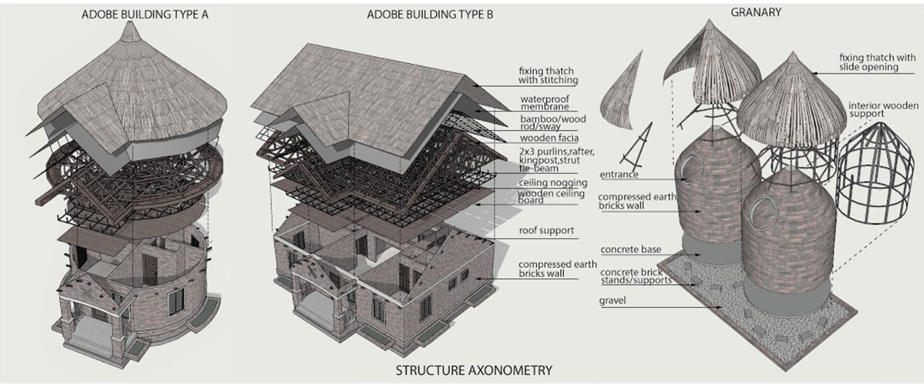June 25, 2021
Faculty partnership addresses shelter crisis in northern Nigeria

A Calgary coffee shop conversation between a medical doctor and an architecture professor led to an initiative to bring affordable housing to displaced people in war-torn north-central Nigeria.
Dr. Emmanuel Gye, MD, clinical assistant professor at the Cumming School of Medicine and Dr. Brian R. Sinclair, PhD, professor of architecture at the School of Architecture, Planning and Landscape (SAPL), connected over a mutual conviction around humanitarian concerns and a desire to empower youth.
Gye and his wife, Pamela — both Nigerian-Canadians who originated from Plateau State — wanted to alleviate the trauma and suffering of displaced people through affordable, innovative, culturally appropriate and sustainable housing. They were particularly interested in housing that could be replicated easily and widely to address the significant housing shortfall in Nigeria. They also hoped to facilitate training displaced people to build the homes, allowing them to develop skills that could translate into earning income.
“As a physician, I am acutely aware that the factors that make people sick are largely out of my control,” Gye explains. "In approaching the challenges of the internally displaced persons in Nigeria, we opted to address one of the social determinants of health and well-being — housing — because we know the impact will be far greater than relying on my medical skills. This knowledge and conviction spurred me to reach out to Dr. Sinclair and his colleagues.”
Sinclair teaches students about architecture’s power to address human rights, wellness, safety and dignity. Together they dreamed up a design competition: the Jinkai Shelter Initiative, drawing from the Hausa words Jinkai (mercy) and Jinka (roof), to attract talented Nigerian architecture students to design housing for those whose lives had been upended.
“We all have a basic human right to shelter,” Sinclair asserts. “Shelter not only keeps us physically protected, but it also critically contributes to our psychological health, our sense of identity, and our need for dignity. The competition was an exceptional opportunity to empower Nigeria’s youth, while concurrently bringing attention to the tremendous humanitarian crises in the country.”
The competition gave students an opportunity to use their knowledge to participate in a design process that is rooted in necessity, with the potential to make a measurable difference in people’s lives.
Students had to embed several considerations into their designs: affordability, the use of low-cost, low-tech local building materials, connection to place, weather, culture and the occupational requirements of their clients — small-scale farmers who need to store crops and house animals.

Benjamin Moses, Crazy World Trends, competition winner.
The designs would be built by individuals with limited skill, using locally available building materials such as compressed earth blocks (CEB) — building bricks compressed through a mechanical hydraulic press or manual lever press. CEBs are a low-cost, sustainable alternative building material prized for their durability, and used by a significant portion of the world population.
Designs also had to take into account the harsh sunlight and dry, dusty winds from the Sahara Desert, which require additional design considerations like creating spherical buildings to minimize the impact of the wind and using reflective (zinc) roofing to keep houses cool.

Benjamin Moses, Crazy World Trends, competition winner.
The entries were reviewed by a high-profile international jury featuring two Nigerian-Canadian professionals with strong ties to Alberta: Edmonton-based architect Samuel Oghale Oboh, former president of the Royal Architectural Institute of Canada, and UCalgary doctoral student, Chika Daniels-Akunekwe (a PhD candidate under Sinclair’s supervision). The jury, led by Sinclair, selected three wining designs and two honorable mentions that all met the criteria of affordability, sustainability and liveability.
“The designs illustrate sensitivity to culture, empathy around hardship, and a spirit of hope for a better future,” explains Sinclair.
One of the competition’s winners, Benjamin Moses reflected on the experience: “The competition [gave me an opportunity] to explore and see Africa vernacular architecture in a different dimension. Integrating the vernacular of existing buildings, I created a design which is sustainable and responsive to environmental conditions and factors such as the different ethnic groups, climate, religious affiliations, cultural beliefs and practices, and art forms.”
The shelter initiative has the potential to deliver housing at a fraction of the cost of conventional approaches. Looking ahead, Gye and Sinclair are continuing efforts and opportunities to create much-needed shelter in Nigeria and beyond, including future design competitions. The Gyes, together with the Rotary Club, are moving into the followup phase of the 2020 competition: training people to create bricks and build the design.




